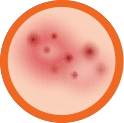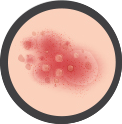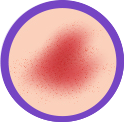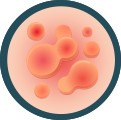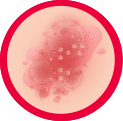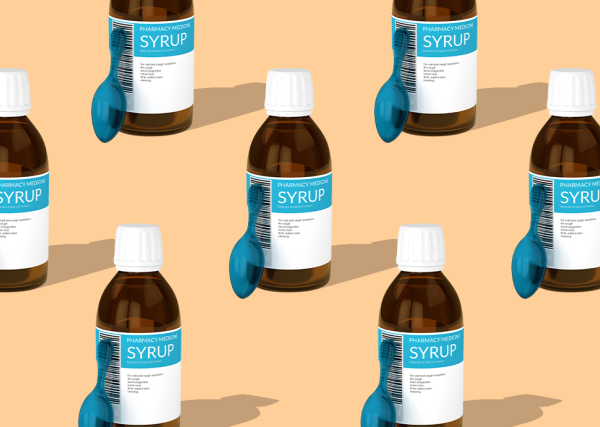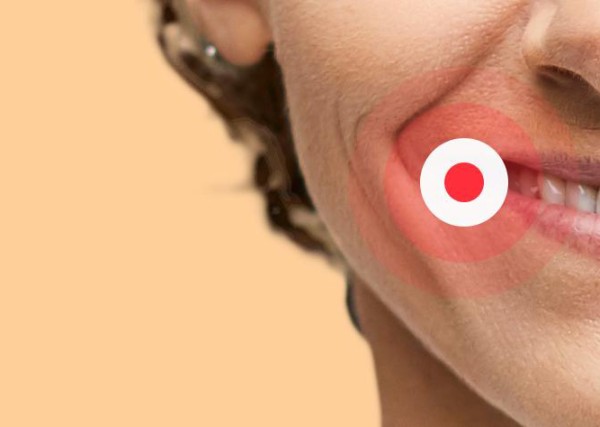
are you itching for relief?
find out what that rash is and how to treat it.
Getting a rash is irritating, but it can also be scary. When your skin starts to bump, lump, or swell, you can’t help but worry. Don’t stress out – get the help you need with MDLIVE. Our board-certified doctors treated more than 60,000 patients with rashes last year and are here to help you 24/7/365 from the safety and comfort of home.
What causes a rash?
Itchy, scratchy rashes can pop up for many reasons. Some of the most common causes are poison ivy, allergies, heat, and reactions to medications. Some rashes, like dermatitis, aren’t contagious, while others, like a viral rash, can spread to others. No matter how you get a rash, you want quick relief to stop the itching and scratching.
Rash treatment.
The first step to treating a rash is to know the difference between the various outbreaks so you can get the right care to relieve your itchy situation. After that, you can decide if you need professional help or if an over-the-counter medication can help. Some rashes are caused by chronic skin conditions like eczema and psoriasis and often require specialist care. Remember, if you have a rash and don’t know what to do, have an MDLIVE virtual doctor visit to determine the next steps you should take.
Different types of rashes.
What's that rash?
An ongoing condition that causes inflamed, itchy, red, cracked, rough skin. Symptoms can flare up or come and go.
Where it occurs on the body:
Eczema can show up anywhere but is most common on the face, hands, elbows, knees, and neck.
When to see a doctor:
While these conditions aren't contagious, they can be extremely irritating. See an MDLIVE doctor and find out if over-the-counter medications can work or if you need an antibiotic.
Small, stinging red lumps or clear, liquid-filled bumps that are prickly or intensely itchy.
Where it occurs on the body:
This rash appears mainly on the neck, shoulders, and chest, but can also spread to other areas covered by clothing.
When to see a doctor:
Heat rashes usually clear up on their own within a few days, but if yours doesn't, you may need medical attention.
Caused by skin-to-skin contact. It appears as a red or reddish-brown rash and can make your skin feel raw, sensitive, and itchy. It can also cause oozing sores, cracked skin, or bleeding.
Where it occurs on the body:
Intertrigo can appear under your arms, between your toes, near your groin, and on other parts of your body that rub together.
When to see a doctor:
This type of rash can clear up on its own, but you may. still need to see a doctor if it lasts more than a few days.
(Poison oak or sumac)
Intensely itchy, red, blistering rash that occurs after contact with the plant in the woods or elsewhere outside. The rash may develop in a few hours or after several days. and can last for weeks.
Where it occurs on the body:
This rash will develop anywhere that your skin was exposed to the plant.
When to see a doctor:
Have an on-demand MDLIVE virtual doctor visit for treatment and a prescription if necessary.
Occurs when you're sick with a virus like the measles, roseola, or shingles. Symptoms include splotchy red spots that can appear in small patches or across several areas of the skin accompanied by fevers, chills, body aches, and fatigue.
Where it occurs on the body:
A viral rash can occur anywhere on your body, from your hands and feet to your back and torso.
When to see a doctor:
Unfortunately, these types of rashes have to run their own course, but a doctor can recommend medications that can provide some relief from your symptoms.
Caused by an allergic reaction to a medication. It can appear as quickly as a few minutes after taking a drug or as long as a few days. It usually appears as red bumps, blisters, and hives, which can peel and become painful.
Where it occurs on the body:
Rashes caused by drug reactions usually stat as small as red spots that gradually spread across your entire body.
When to see a doctor:
Most of these rashes clear up when you stop using the responsible drug. If your symptoms are mild, talk to your prescribing physician or an MDLIVE provider. For more severe reactions, like trouble breathing, require immediate in-person medical care.
The rash care you need.
Rashes aren’t just itchy and annoying – they can also be dangerous if left untreated. Over-the-counter creams, cold compresses, and antihistamines can help if you’re dealing with something minor. However, while some rashes like a heat rash will go away on their own, others, like a poison ivy rash, require medical treatment. So, when should you seek medical attention? Here are a few guidelines.
See an MDLIVE doctor about your rash if:
- Your rash lasts longer than a week
- Your rash doesn’t seem to be improving or is getting worse
- Your rash is spreading to other parts of your body
- Your skin starts to blister
- Your skin is red, swelling, or oozing
- Your rash is painful, and you need relief
Before your virtual visit, you’ll be asked to upload a picture of your rash. Your doctor will use that information combined their professional experience and our proprietary telehealth medical guidelines to give you an accurate diagnosis and treatment plan. Click here to discover more about how our doctors provide reliable virtual care.
If you have a rash and aren’t sure if you need medical attention, have an MDLIVE virtual doctor visit today and get the answers and relief you need.
Posted date: July 20, 2020
